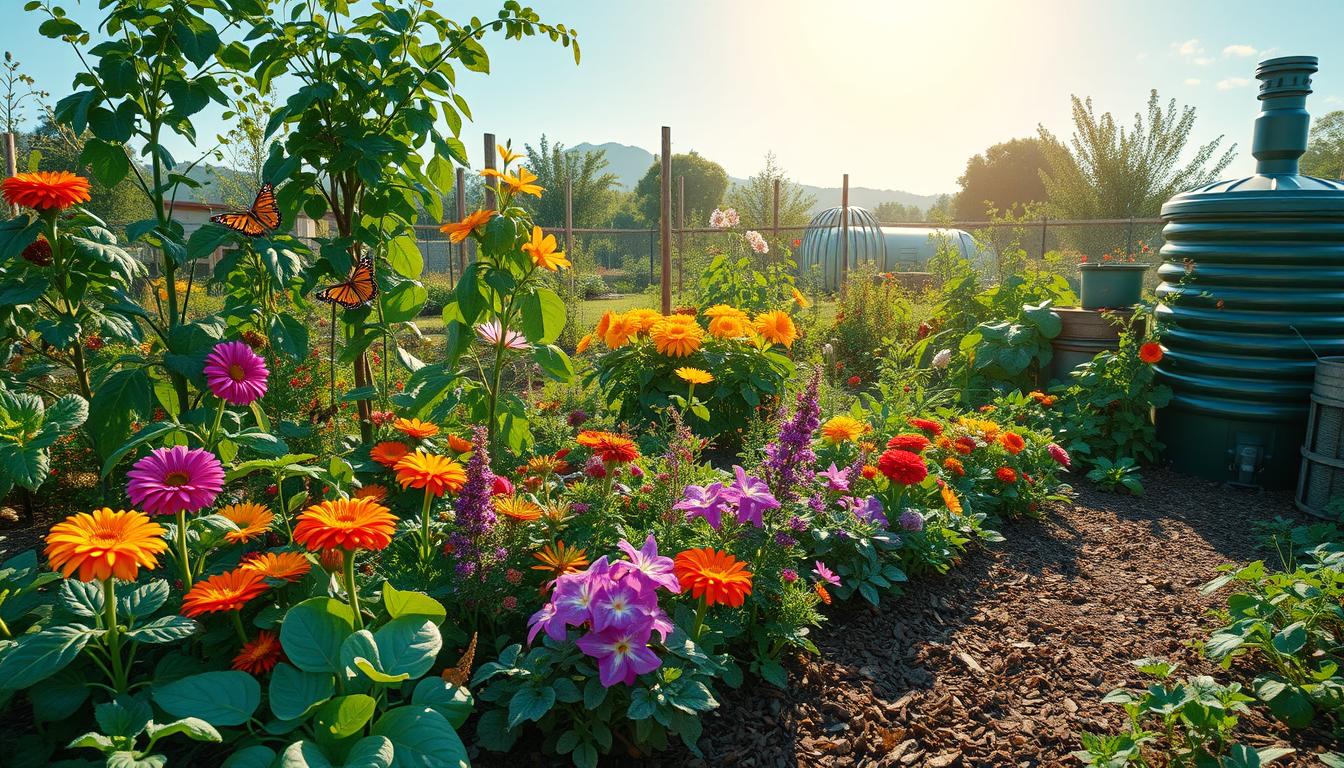I’m excited to share my journey of creating a thriving sustainable garden. I’m here to guide you through the process of growing your own eco-friendly garden. Sustainable Gardening is a great way to reduce your environmental impact and create a beautiful outdoor space.
Through my experience, I’ve learned the importance of organic gardening. It positively impacts your home and community. By adopting sustainable gardening practices, you can enjoy a lush green space and help the environment.
In this article, I’ll give you a step-by-step guide to planning, designing, and maintaining your sustainable garden. We’ll focus on eco-friendly and organic gardening methods. Whether you’re new to gardening or have experience, you’ll find helpful tips to make your yard a thriving sustainable garden.
Understanding Sustainable Gardening
As I explore gardening, I’ve learned how crucial it is to use eco-friendly methods. Sustainable gardening aims to create a balanced ecosystem. It uses natural ways to keep soil healthy, save water, and cut down on waste. This approach helps me reduce my environmental footprint, grow a healthy garden, and help my community.
Some key benefits of sustainable gardening include:
- Conserving water through efficient irrigation systems
- Reducing waste by composting and reusing materials
- Creating a habitat for beneficial insects and pollinators
- Improving soil health through the use of organic amendments
By adopting eco-friendly gardening habits, I positively impact my home and community. Sustainable gardening is great for the planet. It also lets me connect with nature and feel more well.
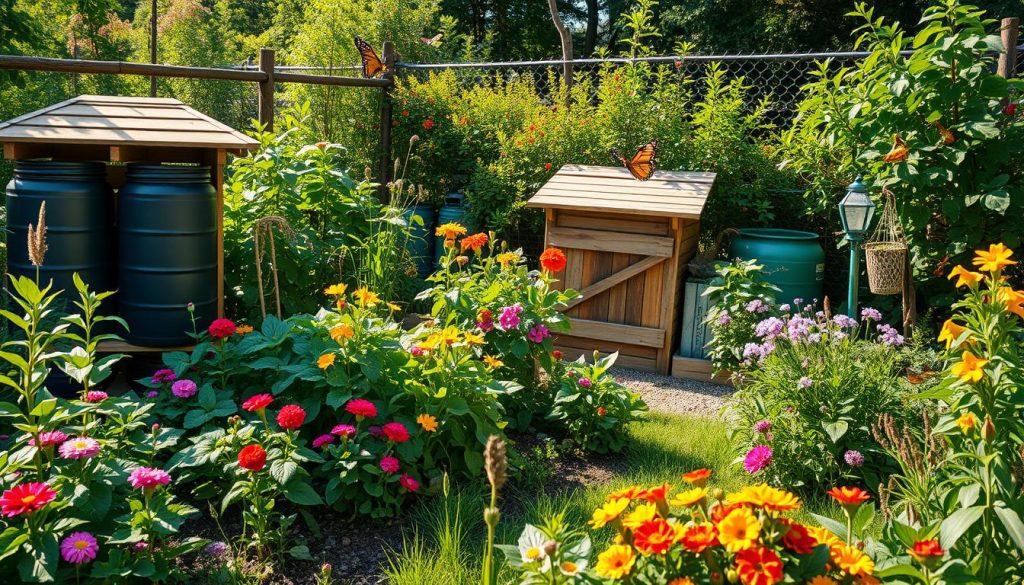
I’m eager to learn more about sustainable gardening. I want to use green practices and lower my carbon footprint. I’m dedicated to making a difference for the environment and my community.
Planning Your Sustainable Garden
When I started planning my sustainable garden, I learned a lot. It’s all about making smart choices to create a green space. This means picking the right spot and designing it in an eco-friendly way. Every choice you make affects the environment, so it’s key to think carefully.
I first looked at my yard’s conditions. I checked the sunlight, soil, and how easy it was to get to. This helped me pick the best plants and what to add to the soil. I also thought about what I wanted my garden to look like. I wanted it to be beautiful and full of life, with native plants and natural materials.
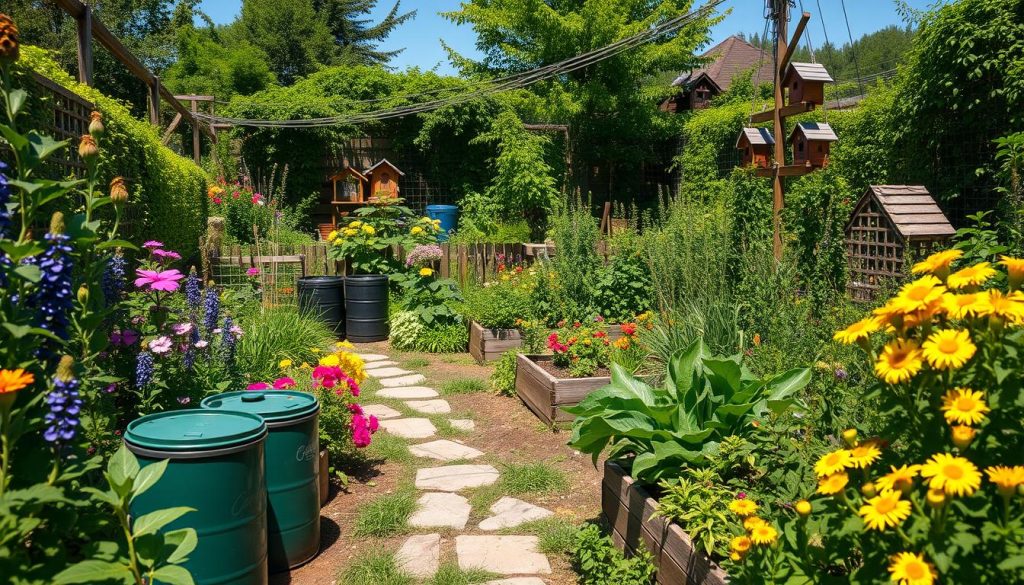
- Choosing plants that are native to your region and require minimal maintenance
- Using natural materials for paths, borders, and other features
- Incorporating a mix of plants that attract pollinators and provide habitat for beneficial insects
- Implementing efficient irrigation systems and rainwater harvesting techniques
By planning your garden with care, you can make a lovely and green space. It will be good for you and the planet.
| Factor | Considerations |
|---|---|
| Location | Amount of sunlight, soil quality, accessibility |
| Plant selection | Native plants, low-maintenance options, pollinator-friendly species |
| Design | Eco-friendly layout, natural materials, efficient irrigation systems |
Selecting Native Plants
Exploring sustainable garden design, I’ve learned the value of native plants. They fit well with local weather and soil, needing less upkeep. Using native plants in my garden helps the environment and supports local wildlife.
In sustainable agriculture, native plants are key to a healthy ecosystem. They offer food and shelter for wildlife, which helps pollinate and control pests. By choosing native plants, I help preserve biodiversity in my garden and beyond.
Why Native Plants Matter
Native plants are special because they’ve adapted to their environments over time. They need less water, fertilizers, and pesticides, making them great for sustainable gardens. Some top picks for sustainable gardens include:
- Black-eyed Susans
- Butterfly Weed
- Lavender
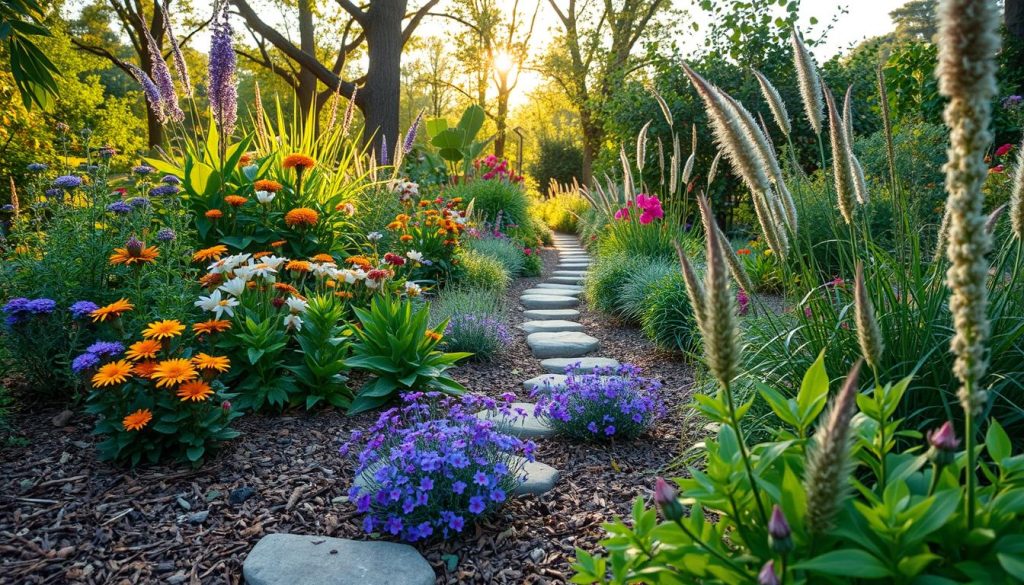
Recommended Native Plants for the U.S.
In the U.S., there are many native plants to choose from. Some favorites are:
- Wild Indigo
- Joe-Pye Weed
- Blazing Star
By adding these plants to my garden, I’m creating a space that’s good for me and the planet.
Implementing Organic Practices
As I care for my sustainable garden, I’ve learned the value of organic practices. This method keeps my garden healthy and supports the environment. By picking organic seeds and plants, I avoid harmful chemicals and pesticides.
Organic gardening offers many benefits:
- Improved soil health
- Increased biodiversity
- Reduced environmental pollution
Choosing Organic Seeds and Plants
It’s crucial to choose organic seeds and plants. You can buy from trusted suppliers or save seeds from your harvest. Organic options are GMO-free and pesticide-free, safer for my garden and the planet.
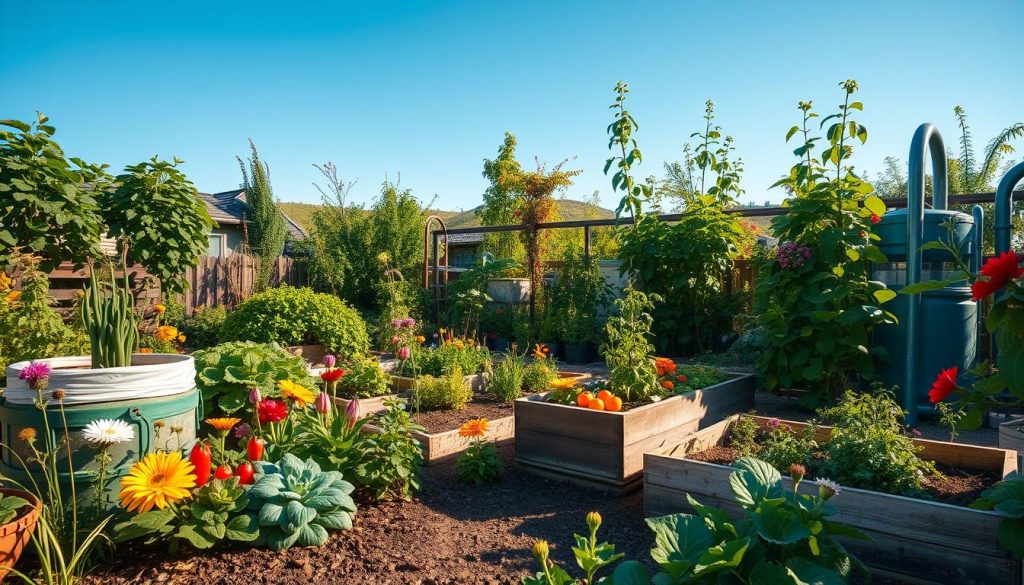
Natural Pest Control Methods
Organic gardening uses natural pest control methods. Techniques like companion planting and crop rotation help avoid pesticides. For instance, marigolds can keep nematodes away from tomatoes, and rotating crops prevents pests and diseases.
| Pest | Natural Control Method |
|---|---|
| Aphids | Neem oil or soap solution |
| Whiteflies | Yellow sticky traps or insecticidal soap |
| Slugs | Copper tape or crushed eggshells |
Importance of Crop Rotation
Crop rotation is key for healthy soil and pest control. It breaks pests’ life cycles, reducing pesticide use. This method also boosts soil fertility and health, vital for my garden.
Water Conservation Techniques
As I learn more about eco-friendly gardening, I see how crucial water conservation is. Using green gardening practices not only helps the environment but also saves water. Here, I’ll share the benefits of water-saving techniques and how to use them in your garden.
By choosing eco-friendly gardening, you can cut down on water use. Here are some tips:
- Rainwater harvesting: Collecting and storing rainwater for irrigation purposes
- Drip irrigation systems: Delivering water directly to the roots of plants, reducing evaporation and runoff
- Mulching: Retaining moisture in the soil, reducing the need for frequent watering
Rainwater Harvesting
Rainwater harvesting is a simple and effective way to save water. It lets you use rainwater instead of municipal water, saving money on your water bill.
Drip Irrigation Systems
Drip irrigation systems are great for watering plants at their roots. This cuts down on evaporation and runoff. It’s perfect for plants that need steady moisture.
Mulching
Mulching helps keep soil moist, so you don’t have to water as often. It also keeps weeds away and controls soil temperature. Just add a layer of organic mulch.
Building Healthy Soil
As I explore sustainable gardening, I’ve learned how vital healthy soil is. It’s the base of a thriving garden, giving plants the nutrients they need. In eco-conscious gardening, creating a balanced ecosystem is key. This has greatly improved my garden’s health and output.
I’ve started adding compost to the soil. This natural method has been a big help, providing plants with the nutrients they need. I’ve also used worms and microorganisms to break down organic matter. Cover crops help improve soil health and reduce erosion, adding nutrients too.
Some key benefits of healthy soil in sustainable gardening are:
- Improved soil structure and fertility
- Increased crop yields and plant growth
- Enhanced ecosystem biodiversity
- Reduced soil erosion and water pollution
In eco-conscious gardening, soil health is a top priority. By using these methods, I’ve cut down on environmental harm while enjoying a lush garden. Whether you’re new to gardening or experienced, I suggest diving into sustainable gardening. You’ll see the benefits of healthy soil firsthand.
| Soil Health Technique | Benefits |
|---|---|
| Adding Compost | Enriches soil with essential nutrients |
| Utilizing Worms and Microorganisms | Breaks down organic matter, creating a balanced ecosystem |
| Using Cover Crops | Improves soil health, reduces erosion, and provides a source of nutrients |
Gardening for Wildlife
As I tend to my garden, I’ve learned how vital it is to create a home for local wildlife. By using eco-friendly gardening methods, I help the ecosystem and support nature’s balance. Sustainable gardening means working with nature, and helping wildlife is key to this.
By offering food and shelter, I draw in helpful insects, birds, and pollinators. This makes my garden more beautiful and helps the local food chain. Simple steps to make a wildlife-friendly garden include:
- Planting native flowers and shrubs that attract pollinators
- Installing a bird feeder or bird bath
- Creating a compost pile to attract beneficial insects
It’s crucial to avoid pesticides when gardening for wildlife. These chemicals can harm good insects and animals, upsetting the ecosystem. I choose natural pest control methods, like introducing beneficial insects or using barriers. This way, I create a vibrant space that supports wildlife and helps my community.
While gardening, I’m always reminded of sustainable agriculture’s role in protecting our planet. By choosing how I garden, I make a difference in the world.
Seasonal Maintenance Tips
To keep my garden thriving, I focus on seasonal maintenance. I clean up debris, prune plants, and apply mulch for each season. This creates a healthy environment for my plants and stops diseases from spreading.
I’m all about eco-friendly gardening. I use natural methods to fight pests and diseases. For example, I use neem oil and introduce beneficial insects to my garden.
Preparing for Each Season
Here are some tips for preparing your garden for each season:
- Spring: Remove winter mulch, prune plants, and apply compost
- Summer: Water plants regularly, mulch to retain moisture, and control pests
- Autumn: Clean up debris, prune plants, and apply winter mulch
- Winter: Protect plants from frost, use frost blankets, and avoid over-watering
Importance of Pruning and Weeding
Pruning and weeding are key to a balanced garden. Pruning helps plants grow healthy and strong. It also encourages them to produce fruit. Weeding stops plants from competing for water and nutrients, reducing the need for harmful chemicals.
Staying Educated and Inspired
To keep your sustainable garden thriving, it’s key to stay informed and motivated. You can do this by checking out different resources, meeting others who share your interests, and going to workshops. This way, you’ll learn a lot about sustainable gardening and farming, helping you make smart choices for your garden.
For sustainable gardening tips, look into online forums, books, and local nurseries. These places are full of info on organic gardening, saving water, and using native plants. By using these resources, you can grow your knowledge and create a healthy garden ecosystem.
Useful Resources for Sustainable Gardening
- Online forums and discussion groups
- Books on sustainable gardening and agriculture
- Local nurseries and gardening stores
Joining Local Gardening Communities
Getting involved with local gardening groups is a smart move. You can learn from seasoned gardeners and share your own tips. These groups often have workshops, events, and meetings where you can network and learn more about sustainable gardening and farming.
Attending Workshops and Events
Workshops and events are great for keeping up with new sustainable gardening methods. These gatherings usually have expert talks, hands-on activities, and demos. By going to these, you’ll be ready to apply sustainable gardening and farming ideas to your own space.
| Event | Date | Location |
|---|---|---|
| Sustainable Gardening Workshop | March 12th | Local Nursery |
| Organic Farming Conference | April 15th | Community Center |
| Gardening Expo | May 20th | Convention Center |
Sharing the Harvest
Looking back, sharing my garden’s bounty with the community has been incredibly rewarding. I’ve joined a
Community Supported Agriculture (CSA)
program. This has connected me with local farmers and gardeners. It gives me access to the freshest, most sustainable produce.
Donating extra from my garden to
local food banks and shelters
has also been fulfilling. It helps reduce food waste and supports those in need.
The real joy comes from
hosting garden-to-table gatherings
with loved ones. Sharing my garden’s harvest and eco-friendly gardening tips has brought us closer. These gatherings, whether a barbecue or dinner party, celebrate our connection to the land and food.
As I keep gardening sustainably, I’m eager to grow my impact. I plan to join local markets and teach gardening workshops. Together, we can create a greener, more sustainable future.

